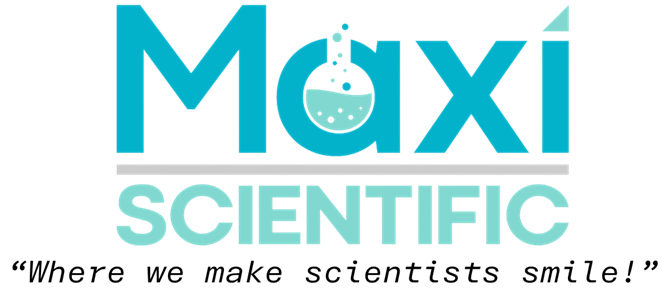Understanding the Different Types of Chromatography in Laboratories
Posted by Maxi Scientific on Jan 5th 2025
Chromatography is one of the most versatile and widely used techniques in analytical and preparative chemistry. Whether you're analyzing complex mixtures, isolating biomolecules, or ensuring product purity, chromatography provides the precision and reproducibility required in modern laboratories. This article explores the fundamental types of chromatography, their principles, and their applications to help scientists select the best method for their needs.
What Is Chromatography?
At its core, chromatography is a separation technique that exploits differences in the physical or chemical properties of components in a mixture. It involves a mobile phase (a liquid or gas) that carries the sample through a stationary phase (a solid or liquid supported on a solid). Depending on how the analytes interact with these phases, they separate as they move through the system.
Types of Chromatography
1. Gas Chromatography (GC)
Principle: Gas chromatography separates volatile compounds based on their distribution between a stationary phase and a gaseous mobile phase.
Key Features:
- The stationary phase is often a liquid film or a solid packed into a column.
- The mobile phase is an inert carrier gas, such as helium or nitrogen.
- Temperature plays a crucial role in separation efficiency.
Applications:
- Analysis of volatile organic compounds (VOCs) in environmental samples.
- Quality control in the petrochemical and food industries.
- Detection of drugs and metabolites in forensic toxicology.
2. Liquid Chromatography (LC)
Principle: Liquid chromatography separates compounds based on their interaction with a liquid mobile phase and a solid stationary phase.
Key Features:
- Widely used variants include High-Performance Liquid Chromatography (HPLC) and Ultra-High-Performance Liquid Chromatography (UHPLC).
- Capable of analyzing non-volatile and thermally unstable compounds.
- Various stationary phase chemistries (e.g., reverse phase, ion exchange, size exclusion) allow flexibility.
Applications:
- Pharmaceutical product testing and development.
- Separation of biomolecules like proteins and nucleotides.
- Analyzing food and beverage additives.
3. Thin-Layer Chromatography (TLC)
Principle: Thin-layer chromatography uses a thin layer of adsorbent material (e.g., silica gel) coated on a flat surface as the stationary phase.
Key Features:
- Simple and cost-effective.
- Visual detection via UV light or chemical staining.
- Limited resolution compared to GC or HPLC.
Applications:
- Qualitative identification of compounds.
- Monitoring the progress of chemical reactions.
- Preliminary screening of complex mixtures.
4. Ion Exchange Chromatography (IEX)
Principle: Ion exchange chromatography separates molecules based on their charge by exploiting ionic interactions between the analytes and the stationary phase.
Key Features:
- Anion and cation exchange columns are available.
- Widely used for biomolecules like proteins and peptides.
Applications:
- Purification of antibodies and enzymes.
- Separation of charged biomolecules such as amino acids and nucleotides.
- Analysis of water quality by detecting ions.
5. Affinity Chromatography
Principle: Affinity chromatography relies on specific biological interactions, such as antigen-antibody or enzyme-substrate binding, to separate target molecules.
Key Features:
- High specificity and selectivity.
- Often uses immobilized ligands on the stationary phase.
- Requires careful optimization of binding and elution conditions.
Applications:
- Purification of recombinant proteins.
- Isolation of specific biomolecules for research purposes.
- Studying protein-protein interactions.
6. Size-Exclusion Chromatography (SEC)
Principle: Size-exclusion chromatography, also known as gel filtration, separates molecules based on their size. Larger molecules elute faster because they are excluded from the pores of the stationary phase.
Key Features:
- Non-destructive to analytes.
- Commonly used in biochemistry and polymer chemistry.
Applications:
- Determination of molecular weights.
- Purification of proteins, polysaccharides, and other macromolecules.
- Analysis of polymers and synthetic materials.
7. Paper Chromatography
Principle: Paper chromatography uses a strip of paper as the stationary phase and separates compounds based on their solubility in the mobile phase.
Key Features:
- Low-cost and simple.
- Limited to educational and qualitative applications.
Applications:
- Identification of pigments and small organic molecules.
- Educational demonstrations.
- Early-stage separation experiments.
Choosing the Right Chromatography Technique
Selecting the best chromatography method depends on several factors:
- Nature of the sample: Volatile compounds are better suited for GC, while biomolecules like proteins require LC or IEX.
- Analytical goals: For high-resolution separation, techniques like HPLC or GC are ideal. For quick qualitative analysis, TLC or paper chromatography may suffice.
- Budget and equipment: Advanced methods like HPLC and GC require significant investment, while TLC and paper chromatography are economical alternatives.
